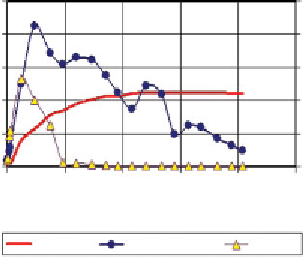Environmental Engineering Reference
In-Depth Information
B.
Perchlorate, ClO4- Extraction
: In another example, perchlo-
rate, ClO
4
-
contaminated soil samples retrieved from an avi-
ation facility near Rancho Cordova, California were treated
to explore the extraction of this species electrokinetically.
The soil contained little clay, but mostly fine to medium
sand and silt. The packed samples were saturated in the lab-
oratory with the groundwater specimen obtained from the
same location that contained high levels of perchlorate. The
laboratory test specimens measured 25.7 % water content by
dry weight, bulk density of 2.8 g/cm
3
, and void ratio of 0.6.
Two tests were conducted in parallel one of which served
as a control test with no electrical current. In the treatment
cell the soil was subjected to constant 30 Volts across the
electrodes residing in chambers filled with the local ground-
water from site. The results of these tests are presented in
figures 2.15 and 2.16.
The current density varied from maximum of 1mA/cm
2
to minimum of 0.006mA/cm
2
, as shown in Figure 2.15. The
efficiency of extraction (i.e., moles of perchlorate per quan-
tity of electricity) is closely related to the current measured
in the soil. The current peaked at 80% removal and dimin-
ished thereafter. Although the applied voltage remained at
30V across the electrodes, the voltage potential measured in
the soil was transient; decreasing thereafter the maximum
removal efficiency was reached. A number of reasons can
be offered for this occurrence, some of which are: loss of
25
10
20
8
15
6
10
4
5
2
0
0
0
100
200
300
400
500
TIme, hrs
Potential in soil
Current
Efficiency
Figure 2.15
Electrokinetic removal of ClO
4
-
from soil retrieved from an aviation facility
in Rancho Cordova, Ca (Pamukcu and Huang, 2001)
















Search WWH ::

Custom Search